by Winding Pathways | Nov 30, 2015 | Mammals, Nature, Pests
We love watching frolicking squirrels in our yard and every year we buy bags of corn for them to snack on. We draw the line when they climb up to feeders and gobble expensive seeds meant for chickadees, nuthatches, and woodpeckers.
Bird feeder companies all tout their “squirrel proof” feeders and a homeowner can spend a bundle on different feeders just to slow the flow of seed from feeder to squirrels’ mouths. Some preventions work better than others but a reliable company is Droll Yankee.
But, being partly of Yankee stock, we took the economical route. To thwart the hungry mammals we mounted our feeders on steel pipes and even ringed some with metal stove pipe. Somehow they managed to dig claws into the metal, climb and feast on expensive seed.
Then we discovered spray grease. It’s sold in hardware stores and is meant to spray on drawer slides, hinges, and other balky metal parts. We sprayed it on the metal pipes holding up the feeders. Squirrels gingerly put their feet on the pipe and backed off as soon as they felt the grease. It works.
Spray grease only lasts a few weeks and needs to be reapplied, but it is a simple way to discourage squirrels from climbing to feeders.
-
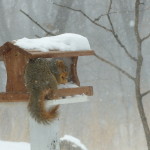
-
Even in the teeth of a storm, squirrels feast to tide them over.
-
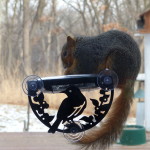
-
Boldly the fox squirrel hunkered down at the window feeder.
-
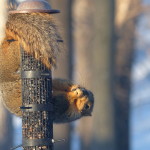
-
Quite the acrobat, this squirrel hung for more than 30 minutes eating seed.
-

-
A cautious squirrel scoping out the action.
-
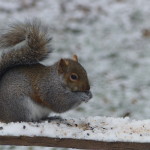
-
A hungry squirrel
-
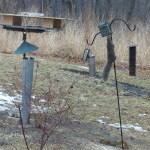
-
Squirrels have an amazing ability to climb just about any vertical pole.
-
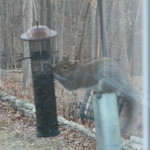
-
This squirrel learned to climb the metal deflector pole and reached into the hanging feeder.
-
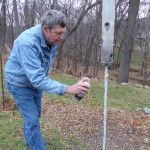
-
This grease works for a while. Remember to re-apply.
by Winding Pathways | Nov 28, 2015 | Birds, Children/Play, Labyrinths, Nature, Travel/Columns, Wonderment
-
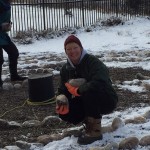
-
Lisa organizing the build.
-

-
Hudson, WI, has a new labyrinth at Healing Waters Health Center. Created by Lisa Gidlow Moriarty and assisted by several volunteers.
-

-
Carefully laying stone in the new labyrinth
What fortune to have contacted Lisa Gidlow Moriarty who was constructing a labyirnth at Healing Waters Health Center in Hudson, WI. Rich and I joined the crew and after the lines were drawn using high technology of a bucket and rope and a tire iron to gouge the circuits, we placed rocks that had been hauled in. The concentric circuits quickly asserted themselves and the labyirnth was completed in no time at all! The day was cold, but the hearts and spirits warm. What a fun experience.
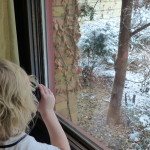
The children are quick to spot birds and squirrels.
Time with extended family in the Twin Cities was restful and hilarious as the children explored outside, spotted birds with “noculators”, and constructed wonderful toys from Legos.
Thanksgiving morning four of us walked a lovely labyrinth at St. Patrick’s Catholic Church in Plymouth, MN. Set down in a barrow area, the labyrinth is formal, well-maintained and has a light feel to it. While set apart, it is visible and still private. Well done.
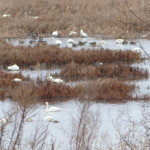
Along the Mississippi
Our drive back along the Mississippi River yielded a fabulous view of Tundra Swans near Minneiska, MN, and a really terrific lunch at a humble looking (on the outside) but spectacular on the inside creamery now restaurant, wine tasting stop and cheesery near Alma, WI. Pretty fabulous. And, the countryside of The Driftless” area (NE Iowa, NW IL, SE MN and SW WI) is gorgeous even on grey November days. Decorah, IA, boasts are pretty great coffee shop and small businesses.
by Winding Pathways | Nov 24, 2015 | Birds, Chickens, Nature
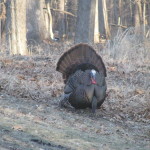
Strutting his stuff
As we enjoy Thanksgiving dinner we pay homage to the great gift the Americas gave the world.
Beef, pork, lamb, and chicken all come from animals with Old World origins. Shortly after Europeans discovered North and South America, Australia, New Zealand, and other new worlds they introduced these familiar and useful farm animals. Before Columbus made landfall, Native Americans knew nothing about these exotic animals. But, they knew turkeys.
Of all common meat animals eaten today only turkeys came from the New World. Before Columbus, wild turkeys abounded across much of North America. Their domestic cousins were tended by some tribes. Treated with great care, the domesticated turkeys were an important source of clothing, tools and food. Among some uses of the tribes of the Four Corners of the United States, turkeys provided feathers for coats, eggs for eating and reproduction, and bones for tools. Evidence exists that the Native Americans cross bred for certain valued characteristics. Europeans quickly developed a taste for turkey and brought them eastward across the Atlantic where they became a common European food.
Our Thanksgiving dinner consists of turkey, potatoes, and winter squash, all Native American foods. Sometimes we add acorn muffins and capstone the meal with a long time family recipe for pumpkin pie, made from a plant that also originated here.
by Winding Pathways | Nov 16, 2015 | Reflections/Profiles, Travel/Columns, Wonderment
Winding Pathways usually blogs about wondrous happenings in backyards. It’s normally rural news about plants, wildlife and weather. Here’s a change from the Big Apple, America’s largest city.
In the midst of rush hour on November 10, on my way back to Iowa after a difficult visit, I, (Rich) took a bus from New Jersey to New York’s Port Authority. When the driver opened the door bus occupants flowed into a river of humanity snaking its way through the monstrous terminal-along corridors, down escalators and through more corridors, until finally we were outside by the New York Times Building.
Needing to find the shuttle to LaGuardia Airport I went to where I thought it would be. No luck. No shuttle. Rather frazzled and running short on time I found a young policeman and asked where the Airport shuttle was. He said, “You look tired. Just follow me”. He delivered me to the shuttle ticket guy.
Then something truly “New York” happened. After buying a ticket and getting seated on the shuttle the driver entered. He was a tiny Asian man who looked to be about 15 years old but certainly was older. I’d be surprised if he weighed 100 pounds and he spoke no English. A blond woman sitting near me also spoke no English. She may have been Scandinavian and could not find the proper ticket in her purse. She and the driver were not able to communicate, so the young driver exited and soon came back with a bus employee with a deep Southern accent who was about three times his size. She politely pointed to the proper ticket nestled with many others in the European woman’s purse.
Everyone smiled as the passenger handed her ticket to the driver. We were soon off to LaGuardia Airport with the young driver ably worming the bus through Manhattan’s snarly traffic.
Three people. None shared a common language. All wanted a positive outcome…….and that happened. It was wondrous.
by Winding Pathways | Nov 9, 2015 | Chickens
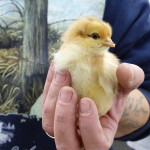
This alert chick will delight a family someday.
There is no better time than The Holiday Season to start thinking about your springtime chicken flock! Yes, now! Make part of your stocking stuffer plans to be a gift certificate for chicks. And, tuck a good chicken book under the tree for winter reading.
Chickens have been part of our lives for over five decades. A daily joy at Winding Pathways is discovering newly laid eggs in out chicken coop. They are as beautiful as jewels and delicious to eat. Our hens recycle kitchen food scraps and garden weeds, snack on insects in their outdoor run, and entertain us with their amazing intelligence, curious antics and colorful feathers. We wouldn’t live without them.
We teach teaching backyard chicken workshops at the Indian Creek Nature Center, and when we ask participants why they are considering keeping a few hens they always seem to say:
*I want my children to learn where food really comes from and to learn responsibility by caring for chickens.
*I want my family to enjoy high quality eggs.
*I want to eat eggs laid by hens that are raised in healthy and humane conditions.
We encourage homeowners to consider keeping a small flock of chickens in the backyard, and there’s good news. The ban against small flocks of chickens is changing fast. Our city, Cedar Rapids, Iowa, for example, changed the ordinance a few years ago to allow chickens. There are but a few restrictions. Only hens are allowed, and people can keep a maximum of six birds. Slaughtering is banned. Other towns across the continent either now allow chickens or are considering changing the ordinance to accommodate citizens who wish to produce food.
Chickens are as at home in suburbia and big cities as they are on farms. Don’t count chickens out if you live in in a metropolis. Many New York City residents, for example, successfully keep chickens, that are often housed in community gardens.
So, in the next couple of months, Winding Pathways encourages readers to do some reading and research to see if chickens are in your future. Look for a detailed blog on the Winding Pathways Website in late December that will have much more detail on chicken husbandry. HERE ARE SOME BASICS:
Where do I get chicks? Local hardware, garden, and farm stores. Find out if they will be selling chicks next spring. Or order on line to arrive in the mail.
What’s the cost? Female chicks, called pullets, cost between $2 and $3 each for most breeds.
When do I order? Tony Halsted, part owner of Hoover’s Hatchery offers this advice: “If you want specific breeds on a specific date place your order in early to mid-January for spring delivery. If you wait we might be sold out”.
When should I have chicks arrive? An ideal time to start baby chicks is three or four weeks before the last killing frost in your area. That’s early to mid-April in northern states and a month earlier in the south.
What will I need? Here are the basics – a coop, nests, feeders, waterers and a place to store feed.
Are they easy to care for? Yes. But remember, they are living creatures that need daily care.
How many eggs will my hens lay? Each bird will lay four to six eggs a week.
Where do I get reliable information? Fortunately, the huge upturn in backyard chicken interest has stimulated the creation of many printed books, blogs and websites crammed with information that helps a novice learn how to care for chickens. Odds are the local library has chicken care books. Also, there are likely people living nearby who have chickens and will share tips. Nature centers and farm and garden stores often sponsor workshops on chicken care, usually in the late winter. And finally, carefully read chicken hatchery websites and catalogs for a host of outstanding information.
Our Favorite Book: CITY CHICKS by Patricia L. Foreman>
Magazine: Backyard Poultry
Website: Scoop From the Coop
Winding Pathways
Hatchery: Hoover’s Hatchery
There are many other excellent books, websites, magazines, and hatcheries.
REMEMBER, WATCH FOR A DETAILED BACKYARD CHICKEN BLOG COMING TO WINDING PATHWAYS LATE WINTER.
















